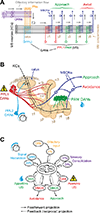Cellular and circuit mechanisms of olfactory associative learning in Drosophila
- PMID: 32043414
- PMCID: PMC7147969
- DOI: 10.1080/01677063.2020.1715971
Cellular and circuit mechanisms of olfactory associative learning in Drosophila
Abstract
Recent years have witnessed significant progress in understanding how memories are encoded, from the molecular to the cellular and the circuit/systems levels. With a good compromise between brain complexity and behavioral sophistication, the fruit fly Drosophila melanogaster is one of the preeminent animal models of learning and memory. Here we review how memories are encoded in Drosophila, with a focus on short-term memory and an eye toward future directions. Forward genetic screens have revealed a large number of genes and transcripts necessary for learning and memory, some acting cell-autonomously. Further, the relative numerical simplicity of the fly brain has enabled the reverse engineering of learning circuits with remarkable precision, in some cases ascribing behavioral phenotypes to single neurons. Functional imaging and physiological studies have localized and parsed the plasticity that occurs during learning at some of the major loci. Connectomics projects are significantly expanding anatomical knowledge of the nervous system, filling out the roadmap for ongoing functional/physiological and behavioral studies, which are being accelerated by simultaneous tool development. These developments have provided unprecedented insight into the fundamental neural principles of learning, and lay the groundwork for deep understanding in the near future.
Keywords: Drosophila; dopamine; genetics; learning; memory; mushroom body; neuronal circuit; olfactory.
Figures

References
Publication types
MeSH terms
Grants and funding
LinkOut - more resources
Full Text Sources
Medical
Molecular Biology Databases
